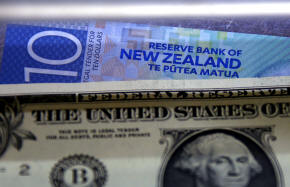Dollar off 1-mth low, kiwi cedes post-rate hike gain
 Send a link to a friend
Send a link to a friend
 [May 25, 2022] By
Sujata Rao [May 25, 2022] By
Sujata Rao
LONDON (Reuters) - The U.S. dollar snapped
a two-day losing streak on Wednesday as Treasury yields paused recent
falls, its gain taking the edge off the euro as well as the kiwi dollar
which had been lifted earlier by a hawkish central bank message.
The Reserve Bank of New Zealand became the latest central bank to raise
interest rates by half a point. While that move was expected, it also
provided hawkish guidance on its policy path, noting a larger and
earlier hike reduced the risk of inflation becoming persistent.
That had helped the kiwi dollar rise as much as 0.8% at one point to a
three-week peak of $0.6514. But as the U.S. dollar gained momentum, it
ceded most of those gains to trade 0.2% higher at $0.648.
"The RBNZ move shows central banks are not in a mood to slow down.
Conditions are pretty tight in a lot of G10 economies and it's a hint
that in the short term policy tightening will remain aggressive," said
Colin Asher, senior economist at Mizuho in London.

Asher noted, however, signs of U.S. economic slowdown -- evident most
recently in housing and business confidence data released on Tuesday --
could force markets to dial down rate hike and inflation expectations.
U.S. 10-year Treasury yields, which hit 3-1/2-year highs earlier in May,
have since fallen some 40 basis points. They slipped another 2 bps on
Wednesday but two-year yields were steady on the day.
The dollar has fallen around 3% after hitting two-decade highs earlier
this month but bounced 0.4% off one-month lows reached earlier this
week.
"My feeling is there is a reasonable chance U.S. rates have peaked and
the dollar has peaked along with it. I don't think it will drop sharply
from here but the pricing of tighter policy is due a pause," Asher
added.
Earlier this week, the dollar was also dented by European Central Bank
chief Christine Lagarde, who flagged an end to negative interest rates
in the coming months.
[to top of second column] |

A New Zealand ten dollar note sits underneath a United States one
dollar bill in the window of a currency exchange teller in Sydney,
Australia, March 10, 2016. REUTERS/David Gray/File Photo

Lagarde's comments implied an increase of at least 50 basis points to the
deposit rate and fuelled speculation of bigger hikes this summer.
But while that lifted the euro to one-month highs of $1.0748 on Tuesday, it
slipped 0.6% on Wednesday, to $1.067.
ECB board member Fabio Panetta took some steam out of the single currency when
he warned of a "normalisation tantrum" caused by taking interest rates to
"neutral" settings.
The euro also pulled back 0.3% against the Swiss franc, which has firmed in
recent days after central bank officials said they would not hesitate to tighten
policy if inflation stayed above target ranges.
Later in the day, traders may glean clues about the pace of tightening by the
Federal Reserve, when minutes of the last policy meeting emerge.
Already, in an essay published on Tuesday Atlanta Fed President Raphael Bostic
warned that headlong rate hikes could create "significant economic dislocation,"
urging his colleagues to "proceed carefully".
"The Fed, of course, remains focused on inflation, but if inflation reads were
(to) start to moderate, then Bostic has opened up the possibility of a Fed
pause," Tapas Strickland, a markets economist at National Australia Bank, told
clients.
(Reporting by Sujata Rao in London and Kevin Buckland in Tokyo; Editing by
Jacqueline Wong)
[© 2022 Thomson Reuters. All rights
reserved.]This material may not be published,
broadcast, rewritten or redistributed.
Thompson Reuters is solely responsible for this content.
 |